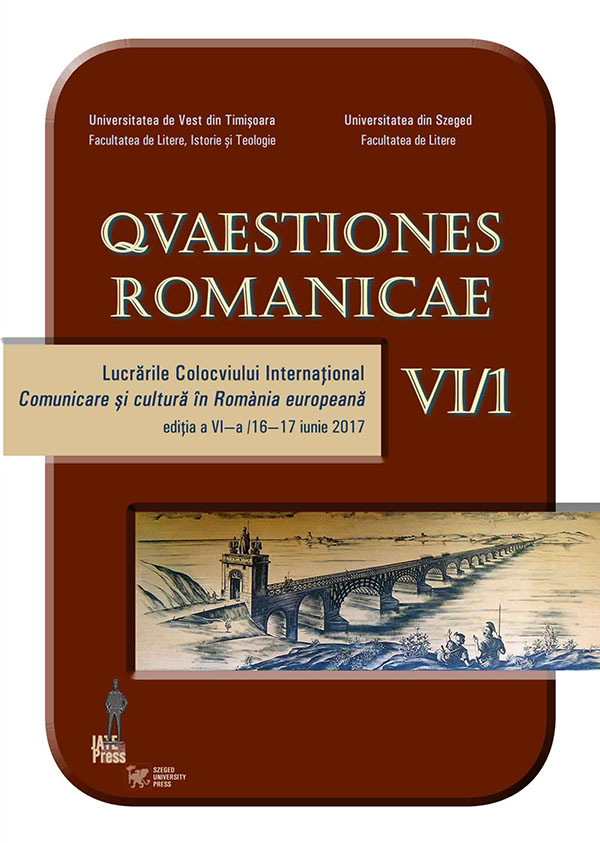La recette du roman d’aventures réinterprétée dans un récit de songe de Marguerite Yourcenar, « La route au crépuscule »
Abstract: (The Recipe of the Adventure Novel Reinterpreted in an Oneiric Transcription by Marguerite Yourcenar ”La route au crépuscule”) Important dreamer, transcriptor and theoretician of an original category in the field of nocturnal oneiric, the so-called “rêve lyrique ou halluciné”, Marguerite Yourcenar is at the same time a writer interested in dream. Her writings from the ‘30s, especially her collection of oneiric transcriptions of 1938 Les Songes et les Sorts, confer a multiple role to the dream, perpetuated for that matter, in the following periods of her creation, in fiction and in autobiography: simple literary topic, such as love, death and illness, discrete instrument for investigating the interiority, together with the myth and legend, aesthetic reference of great value, in competition with the artistic or geographical analogy, a particular type of writing, who’s mark reminds us of the poem written in prose, the adventure novel (through the density of events, dynamism, fabulous or terrifying atmosphere) or the memoirs. The present work proposes a reconstruction of the oneiric theory of Marguerite Yourcenar, focused on the category of the lyric or hallucinating dream (“rêve lyrique ou halluciné”), as formulated in the preface to the collection Les Songes et les Sorts: the attempt to define that nocturnal oneiric category, the suggestions of the dreamer regarding the transcribing method and the reading tracks which she authorises (the dream as an account of the authenticated nocturnal adventures “compte rendu d’aventures nocturnes authentifiées” and the dream as memoires of her dreamed life “mémoires de [s] a vie rêvée”). In the second part of the paper we will illustrate the theoretical ideas of Marguerite Yourcenar on an adventure-based transcription entitled “La route au crépuscule” and we will analyse the influence exerted on the writing of the dream by the adventure novel, with its dynamism, density of events, and its varied decorations, as well as by the detective novel, with its terrifying atmosphere and the enigma game it is proposing. Such a transcript shows, in our opinion, that we are dealing with a fiction rather than an expression of interiority, despite the authenticity claimed by the dreamer.
Keywords: theory of dream, lyric or hallucinating dream, oneiric transcription, poem written in prose.
Résumé : Rêveuse de calibre, transcriptrice et théoricienne d’une catégorie onirique originale appelée « rêve lyrique ou halluciné », Marguerite Yourcenar est à la fois une écrivaine intéressée par le rêve. Ses écrits des années 1930, notamment le recueil de transcriptions oniriques personnelles intitulé Les Songes et les Sorts paru en 1938, assignent au rêve un rôle complexe, perpétué d’ailleurs dans ses périodes ultérieures de création : simple motif littéraire, comme la mort, la maladie ou l’amour, outil discret d’investigation de l’intériorité, au même titre que le mythe ou la légende, référence esthétique hautement valorisée, en concurrence avec la référence artistique ou la référence géographique, formule particulière d’écriture où le poème en prose glisse vers l’aventure, l’investigation policière ou l’observation historique. Nous nous proposons de reconstituer tout d’abord la théorie onirique yourcenarienne, centrée sur la catégorie du « rêve lyrique ou halluciné », telle qu’elle a été dressée dans préface du recueil Les Songes et les Sorts : la tentative de définition de cette catégorie de l’onirisme nocturne, les suggestions de la rêveuse concernant la méthode de transcription et les pistes de lecture qu’elle « autorise » (le rêve comme « compte rendu d’aventures nocturnes authentifiées » et le rêve comme « mémoires de [s]a vie rêvée »). Nous avons choisi un songe centré sur l’aventure pour illustrer les propos théoriques yourcenariens, mais surtout pour analyser les influences de quelques genres canoniques sur l’écriture du rêve : le roman d’aventures, avec son dynamisme, sa densité événementielle et ses décors, le roman policier avec son atmosphère terrifiante et le jeu à l’énigme. Un songe comme « La route au crépuscule » montre, à notre avis, que le récit de rêve est plutôt une fiction bien tenue en main qu’une expression de l’intériorité, en dépit de l’authenticité clamée par la rêveuse-transcriptrice.
Mots-clés : théorie onirique, transcription onirique, poème en prose, rêve lyrique ou halluciné.
